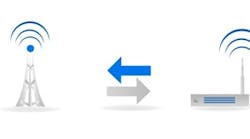Here are some thoughts on the January "Without Wires" column.
I agree that in a vast majority of applications, wireless is not used in place of wires. Wireless is used instead of doing nothing at all or doing it manually. For instance, today essential assets have no health monitoring. Wireless enables essential asset monitoring for heat exchangers, pumps, fin fan coolers, blowers, etc.
Wireless also enables energy conservation measures such as steam trap monitoring and sub-metering of steam and chilled water for cost accounting. It enables health, safety and environmental (HS&E) improvement by liberating field operators from checking well heads and walking the plant reading gauges, variable-area flowmeters, sight glasses, using dipsticks and collecting grab samples, as well as eliminating maintenance rounds with portable vibration testers and temperature guns, etc.
All these applications are "beyond the P&ID." That is to say, site modernization beyond the P&ID is the "killer app" for wireless. In an existing plant, all that is wired remains wired, but everything which is not automated (and therefore not on the P&ID) can be covered using wireless. A wireless mesh network can be deployed in an existing plant with minimal risk because you install a single gateway at the edge of the plant unit. With a full-mesh topology, nothing has to be installed inside the plant unit itself. A full-mesh minimizes risk.
This compares favorably to star-backbone topology, which requires multiple backbone routers to be installed throughout the plant and which need to be wired up with the backbone and hazardous area power. This has a greater risk of damage to the existing plant. Note that a "full mesh" is required to eliminate the backbone routers, with devices supporting multi-path mesh routing with up to seven hops or more. Just two to four hops will not be sufficient—backbone routers would still be required.
Yes, WirelessHART is the leading wireless protocol. It leads because it was designed specifically to meet user needs gathered at the start of the project, such as those in the NAMUR NE124 specification, and later verified by NAMUR at the BASF plant in Ludwigshafen, Germany. These needs include availability and reliability, real-time capability, security, coexistence, certified interoperability and interchangeability, easy integration in DCS, version and lifecycle management, long battery life, and use of existing, familiar tools for commissioning and maintenance.
Unlike Foundation fieldbus, where the technology is adopted wholesale throughout the entire plant in a new project, we will not see a totally wireless plant for a long time yet. This doesn't mean that the thousands of sites where WirelessHART has already been deployed are trials (or kicking the tires).
Rather, WirelessHART is deployed in existing plants which were fully automated years ago by yesteryear's definition of fully automated. These plants can, using wireless, enable lots more automation for essential asset monitoring, energy conservation measures, and to improve HS&E.
This is how WirelessHART is solving real plant problems today, and it is a great success by any measure. Some sites have hundreds of wireless transmitters. Other plants can benefit from following these same applications. When these old plants were built, automation was very expensive because of the high cost of I/O cards and running wires for 4-20 mA and on/off signals. Today, automation is lower cost thanks to wireless, and it can be added in an existing plant with much lower risk than running wires.
Jonas Berge
[email protected]




